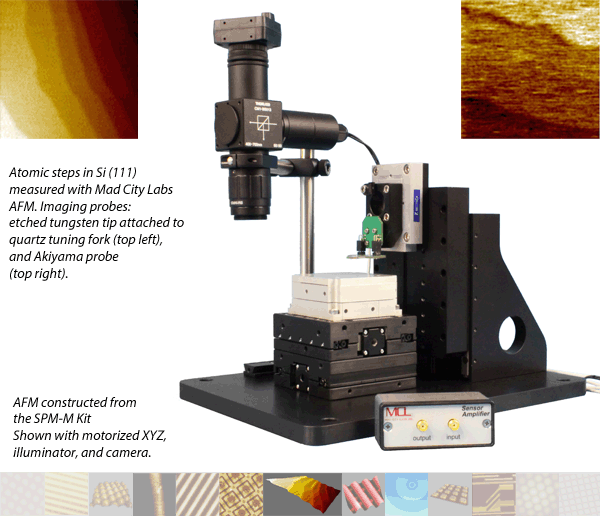 Image Gallery Image Gallery
Seeing is Believing!
The images below were acquired using similar configurations to the SPM-M Kit.
Si (111) Atomic Steps(312pm monatomic layer thickness)2μm x 2μmData taken using MadPLL® with Nano-HS3 3-axis nanopositioning system and etched tungsten tip on a quartz tuning fork. Si (111) Atomic Steps(312pm monatomic layer thickness)1.76μm x 2.02μmData taken using MadPLL® with Nano-HS3 3-axis nanopositioning system and Akiyama probe. Calibration grid(100nm tall lines, 2μm apart)10μm x 10μmUnidirectional scanSelf oscillation mode, constant probe signalZ force feedback: frequencyData taken using MadPLL® with Nano-HS3 3-axis nanopositioning system and Akiyama probe. Calibration grid(100nm tall pegs, spaced 2μm apart)10μm x 10μmUnidirectional scanSelf oscillation mode, constant probe signalZ force feedback: frequencyData taken using MadPLL® with Nano-HS3 3-axis nanopositioning system and Akiyama probe.Fly eye100μm x 100μmBidirectional scanPLL mode, constant probe signalZ force feedback: frequencyData taken using MadPLL® with Nano-OP30 nanopositioning system (Z-axis), Nano-OP100 nanopositioning system (XY axes) and Akiyama probe.Human hair100μm x 100μmBidirectional scanSelf oscillation mode, constant probe signalZ force feedback: frequencyData taken using MadPLL® with Nano-OP30 nanopositioning system (Z-axis), Nano-OP100 nanopositioning system (XY axes) and Akiyama probe.PMMA pattern, uncured10 μm x 10 μmBidirectional scanSelf oscillation mode, constant probe signalZ force feedback: frequencyData taken using MadPLL® with Nano-OP30 nanopositioning system (Z-axis), Nano-OP100 nanopositioning system (XY axes) and Akiyama probe.Integrated circuit100 μm x 100 μmBidirectional scanSelf oscillation mode, constant probe signalZ force feedback: frequencyData taken using MadPLL® with Nano-OP30 nanopositioning system (Z-axis), Nano-OP100 nanopositioning system (XY axes) and Akiyama probe.Calibration grid40 μm x 40 μmUnidirectional scanSelf oscillation mode, constant probe signalZ force feedback: frequencyData taken using MadPLL® with Nano-OP30 nanopositioning system (Z-axis), Nano-OP100 nanopositioning system (XY axes) and Akiyama probe.Calibration grid(100nm tall, 10μm pitch)70 μm x 70 μmUnidirectional scanPLL mode, constant probe signalZ force feedback: frequencyData taken using MadPLL® with Nano-OP30 nanopositioning system (Z-axis), Nano-OP100 nanopositioning system (XY axes) and Akiyama probe.Etched structures80 μm x 80 μmBidirectional scanSelf oscillation mode, constant probe signalZ force feedback: frequencyData taken using MadPLL® with Nano-OP30 nanopositioning system (Z-axis), Nano-OP100 nanopositioning system (XY axes) and Akiyama probe.
|
![]()





